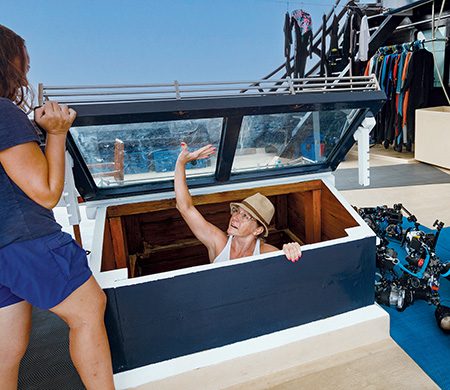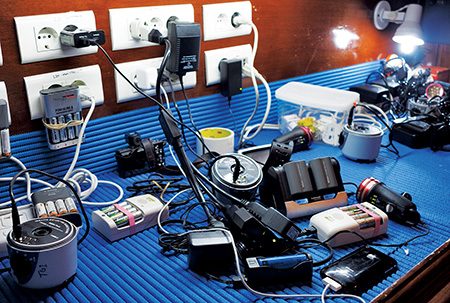Preparedness for liveaboard operators and divers
On Sept. 2, 2019, the small passenger vessel Conception burned to the waterline off Santa Cruz Island, California, killing 34 people. This wasn’t the first liveaboard fire, but the fearful reactions to this deadly tragedy echoed throughout the scuba industry. Liveaboard fires that have occurred since this incident have further fueled industry concerns.
Investigations following the Conception tragedy revealed several factors that likely contributed to the fire and the substantial number of fatalities, leading to an updated Code of Federal Regulations (CFR) and new fire safety rules from the U.S. Coast Guard (USCG) to help liveaboard operators and divers be better prepared for a fire or evacuation.
Findings from Conception
The National Transportation Safety Board (NTSB) published a detailed review of the Conception incident in their Marine Accident Report (NTSB/MAR-20/03), which identified several causes for the severe loss of life.
Investigators believe the fire started in the salon directly above the bunkroom where people were sleeping. Both exits from the below-deck bunkroom led up to the salon. The bunkroom’s fire alarms would not have activated until the fire was well-developed, so both means of escape were likely inaccessible before the alarms awakened anyone.
• Fire detection: Only the bunkroom, as the only overnight accommodation space, was required to have smoke detectors.
• Means of escape: The two means of escape from the bunkroom both exited into the salon.
• Lack of roving patrol: No crew member was awake or patrolling when the accident occurred.
• Safe handling operations: The likely source of ignition was the battery charging stations in the salon, although a confidential report by the Bureau of Alcohol, Tobacco, Firearms and Explosives allegedly suggests the fire started in a plastic trash can in the salon.
• Ineffective company oversight: Reports indicate a lack of crew training and emergency drills and procedures.



Guidance for Divers
Lessons learned from the Conception and other dive boat fires can help guide actions you can take to ensure your own safety.
• Understand your means of escape.
— Make sure that the crew briefs you about how to exit living spaces. There should be at least two unobstructed ways to get out. While the crew may discuss the location of emergency exits, these exits are often not obvious or can be confusing to operate. Go to the exits and, if allowed, open them to ensure they are working properly. Remember, fires produce black smoke and darkness.
• Follow the dive boat operator’s rechargeable battery protocols.
— Many boats have implemented new rules for where to charge batteries, so always learn and follow them.
— Bring your own chargers from the original equipment manufacturer. Before you leave home, ask about the boat’s power supply, including voltage, power/current, and frequency.
• Ask about the crew’s overnight fire watch protocols, and observe the personnel in action.
• Take drills seriously, and offer to help the crew perform them. All vessels are required to conduct emergency drills, including fire, person overboard, missing diver, or abandon ship. The crew may ask you to perform some basic functions to familiarize yourself with emergency gear.
— Check the location of life preservers, and learn how to put them on.
— Locate the fire extinguishers in the living areas of the boat.
— If the operator does not perform a fire drill or at least a walk-around and briefing, be sure to ask about it.
• Consider bringing a portable, economical carbon monoxide monitor for added assurance when your cabin is below deck. This device can also test suspect cylinder breathing gas.
• Keep the following items close to your pillow and ready to grab in an emergency:
— waterproof flashlight
— a “go bag,” which is a drybag no larger than 2 liters (so as not to impede your exit) containing your passport, daily medications, credit cards, phone, glasses, and any other important items
— fume (smoke) hood
— In some cases the boat operator may instruct you to leave everything behind, so check with them at the start of your trip.
Guidance for Liveaboard Operators
The NTSB Marine Accident Report of the Conception fire offered several recommendations that the USCG adopted as an interim rule (USCG-2021-0306) in December 2021 and that were later incorporated into the CFR (46 CFR: Chapter 1: Subchapters K and T).
Reading and understanding the CFR can be cumbersome. The following summary can help operators understand the CFR changes, to whom they apply, and the deadlines for implementation, which were staggered because some changes were more extensive to fulfill.
• Implementation by March 28, 2022
— Conduct passenger emergency egress drills.
— Post a passenger safety bill (including egress plans) in all accommodation spaces.
— Develop handling procedures for the safe operation and storage of potentially hazardous items such as rechargeable batteries.
— Develop and run crew firefighting and emergency egress drills.
— Submit a plan for the installation of monitoring devices to ensure the wakefulness of the roving patrol. The USCG will work with the operator to determine a reasonable implementation schedule.
• Implementation by Dec. 27, 2022
— Install interconnected fire detection systems in all spaces where passengers and crew have routine access.
• Implementation by Dec. 27, 2023
— Provide two unobstructed means of escape that are not located directly above or dependent on a berth. The means of escape must be independent such that one incident will not block both exits.
Prior to these CFR changes, the USCG had last implemented relevant safety regulations, including requirements for portable fire extinguishers, in March 1996, and they were applicable only to newly constructed vessels. Regulations from 1996 and those from 2021 now apply to all small passenger vessels that either operate on U.S. coastal or ocean routes or have overnight accommodations for passengers, irrespective of build date.
USCG regulations apply only to U.S. registered vessels and those operating in U.S. territorial waters. All vessel operators, however, can refer to these regulations to avoid tragic incidents.
We can make diving safer by learning the lessons from history.
© Alert Diver — Q1 2024